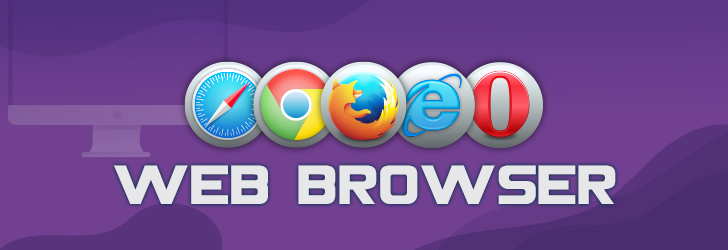
A Web browser also referred commonly as "browser" is a software which is used to access World Wide Web (www). The browser identifies individual URLs and displays the corresponding page on the user's device.
A web browser is available on all devices including desktops, tablets, and mobile phones. To view a web page in a human-readable format, a user requires a web browser installed on the device.
Most often than not, people confuse search engine with a web browser. However, they are distinguishably different. A search engine is used to search for information or websites on the Internet. One such example is google.com. On the other hand, to access a search engine or any website, you need a web browser to view them.
The first ever built web browser called, WorldWideWeb, was invented by Tim Berners-Lee in 1990. Post this, other web browsers such as Mosaic, Netscape Navigator, and Internet Explorer were introduced in the early 1990s.
Commonly used web browsers
Few of the most commonly used web browsers are:
- Chrome: Chrome was first launched in 2008 and has been the most popular web browser. This is available on all devices and is equally popular across all platforms. This is free to download and provides access to multiple extensions. With good browsing experience, Google Chrome also provides features such as private browsing, phishing/malware filters.
- Safari: This is owned by Apple Inc and is popular amongst Mac users. It is a clean and fast web browser and provides most of the modern-day web browser features. This provides private browsing along with pop-up block functionality.
- Mozilla Firefox: This again is a popular web browser which provides a lot of add-on extensions. It is available for Linux as well as Android. It also provides a powerful developer tool, which makes it a suitable choice for a web developer. You can also add custom extensions. Firefox provides features such as chat extensions, spam filters.
- Internet Explorer: This is the default browser for Windows OS and is developed by Microsoft. The IE was replaced by Edge on Windows 10 devices. Prior to Chrome, Internet Explorer was one of the most commonly used web browsers. It has few intuitive features such as SmartScreen filters, Active X capabilities, add-ons, and customizations.
- Opera: This is a free basic version browser which is fast. This does have a few compatibility issues with certain websites. It provides features such as developer tools, page zooms, phishing filter, Bit Torrent.
A few other non-popular web browsers
- Slimjet
- Maxthon
- SlimBrowser
- Netscape Browser
- UC Browser
- Yandex
- Vivaldi
- SeaMonkey
- Chromium
- Pale Moon
How does a web browser work?
A web browser acts as a medium of communication between web servers and the end user. A web browser is a software application which is pre-installed on your device. Whenever a user wants to access any resource over the web, the user must open the web browser such as Google Chrome and type the URL of the resource on the address bar of the web browser.
A URL is used to uniquely identify a resource or a page over the web. When the web browser contacts the web server, in most cases the pages are built using HTML. However, this can also be pdf or images.
A browser interprets these HTML pages and renders it for users to view it. Web browsers are powerful to interpret animations, images, and applications usually created using Java, JavaScript, AJAX or ActiveX.
In certain cases, if the browser is not capable of displaying certain applications or animations, then the browser would prompt you to install the required plug-in.
On a higher-level, a web browser does these 2 things:
- Contact DNS: Once the user types in and enters a URL on the browser address bar, the browser contacts a DNS for address resolution. From here it gets the actual IP address to be contacted.
- Contact server: Once the browser has the IP address, it contacts the concerned server and fetches the pages.
Web browsers contain a rendering engine which may work slightly different based on the web browser. The rendering engine is responsible for parsing the HTML, images, pdf, flash files and others which are received from the web server. With rendering, this also is responsible for the appropriate loading of the complete page.
Along with displaying the page, a web browser also provides some additional features such as providing web development tools, privacy and security filters.
Features of a web browser
Web browsers are not restricted to only displaying a web page, they perform more sophisticated tasks. Most common browsers provide the below-mentioned functionalities.
- Allows to bookmark pages
- Supports private mode browsing
- Support customizations using extensions and plugins
- Allow the user to open multiple web pages either on separate tabs or different browser windows
- Refresh button to reload a page
- Back and forward button for easier navigation
- Stop button to abort page loading
- History to view all the browsing history
- Caching of details
- Cache clear based on duration
- Download options to view all downloads
- Sophisticated developer tools
- Supports JavaScript and popular UI technologies debugging
- Privacy and security settings
- Auto updates
- Spam and malware filters
- Proxy setup
- View site and certificate information with certificate downloads
Share this post
Leave a comment
All comments are moderated. Spammy and bot submitted comments are deleted. Please submit the comments that are helpful to others, and we'll approve your comments. A comment that includes outbound link will only be approved if the content is relevant to the topic, and has some value to our readers.

Comments (0)
No comment